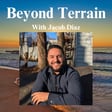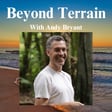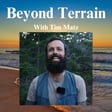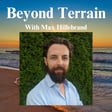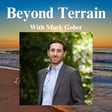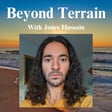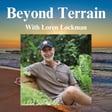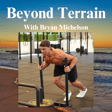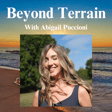Introduction and Guest Introduction
00:00:00
Speaker
Welcome everybody to another episode of the Beyond Drain podcast. We're joined by Dr. Shiva here today. We're going to talk about some very interesting topics. We're going to jump right into it because we're actually live right now in his channel.
Dr. Shiva's Presidential Run and Movement
00:00:09
Speaker
So we've been talking about clean raw food certification. I'm super looking forward to this episode. Yeah. Dr. s Shiva, thanks so much for coming on today.
00:00:18
Speaker
Sure, Levy, I'm looking forward to sharing this with you because I think you know that um my run for president in the United States and the movement that we've created Truth Freedom Health, we do a lot of obviously work exposing the what we call the obvious establishment and the not so obvious establishment. But it's really important also to share with people solutions that
Clean and Raw Food Certification Overview
00:00:39
Speaker
we've created. And the Clean and Raw Food Certification is a bottoms up um result of a very powerful food certification that's not controlled by the government. It actually comes bottoms up and it took us 10 years to build this. But we have many, many people, you know, small ingredients manufacturers, some large ones um who have embraced this certification because it's a way to really define what is quote unquote clean food. And that's what I want to share with um with you today. Amazing.
Defining Health and Food Certification
00:01:16
Speaker
Yeah, I think it's definitely needed. And um I think you take a great perspective on it. So before we start, I like to ask an introductory question. I like to ask my guests, what is health? So we kind of define health here, I'd like to hear your perspective on it. And of course, you could relate it to the reason for the creation of the certification as well.
Interconnected Principles: Truth, Freedom, Health
00:01:34
Speaker
um Because of course, food has plays a large role in this and this topic as well. So yeah, what what does health mean to you? How does it manifest? What does it look like? Yeah, so if you see this you know if you see this bumper sticker that we have, you see it says Truth, Freedom, Health, and I'm not sure if you can see that, right? Yeah. Now, you notice health is at the bottom here, which is sort of the foundation of the other two things, truth and freedom. um So let me define what health is.
00:01:59
Speaker
um So those words Truth Freedom Health Lab are really not, it's not just a slogan. Truth Freedom Health is really a fundamental um Trinity, a free phenomenon that takes place in nature. And in engineering systems science, we call it transport conversion storage, movement of information, matter and energy, which is transport. The conversion of information, matter and energy within one form to another.
00:02:31
Speaker
And then the structural piece which stores information, matter
Infrastructure of Health for Truth and Freedom
00:02:34
Speaker
and energy. Okay. So these same three principles show up also in ancient systems of yoga and medicine. The Indians called it bhaktha pithankatha. All right. And they used this viewpoint to really understand the body as a system. So they didn't look at the, um, the body as organ systems. They looked at it more as, okay, if you have a transport issue and movement issue,
00:02:59
Speaker
That's circulation. Well, that could affect your breathing, the movement of air. It could also affect the movement of blood. You say, if you have a conversion issue, that would affect cognition. It would also affect digestion. And now we know the gut and brain health are
Societal Change Movement Framework
00:03:13
Speaker
connected. So this is a profoundly different way to look at the world. And I made this interconnection as a part of my Fulbright work. when you ask So you know being a political activist, my view was if we're going to build a movement to what I call shatter the swarm, we also need a ah framework and this same framework supports even that truth freedom health is a reflection of that same framework freedom is a movement of information matter and energy right so a society that allows you to move information matter and energy is a free society freely right or you can measure it a society that allows conversion to take place what is conversion taking all sorts of wacky ideas using the scientific method in coming to
00:04:00
Speaker
Truth. And truth keeps getting refined in this process. So truth is many ways of verb. But that's a conversion process. And third is the infrastructure which sustains this, which is health. So when you ask me what health is, health is the infrastructure that is necessary for freedom and truth to survive. And you cannot separate one from the other. So there are a lot of people who do yoga and maintain their health.
00:04:27
Speaker
but they're not into fighting for freedom. They just want to be a little yoga Nazis and narcissistic people who just take care
Process of Food Certification
00:04:32
Speaker
of their health to me. That's not health. So health is intimately connected to truth as well as freedom. You can't separate these. That's why you notice I didn't put truth, freedom and health, right? Or truth, comma, freedom and comma health. They're all one. So health is manifested in truth and freedom, but fundamentally it's the infrastructure which sustains the ability to to pursue freedom and to do science in this case. So that's my definition of health. Beautiful. Yeah, great connection. I really, really like the way you put that there too. So I assume that part of this, right, led to the creation of this sort of food and certification and and much of what you've accomplished as well, right? so
00:05:17
Speaker
Um, maybe we can dive right into this clean raw food certification. Uh, I just want to hear maybe how you developed it, you know, how it pertains to the Trinity that you were just speaking of and how it pertains to all of your work and and how you believe that we should move forward as a, as a society.
Pillars of Food Safety and Bioavailability
00:05:34
Speaker
Yeah. So I think one of the things to understand Lev, um, is the following, you know, I'm going to share some slides or if you want to grab it later, you can incorporate it, but you can get it from night. I can't share it with you, but here's the bottom line.
00:05:47
Speaker
um What is quote-unquote good food? Okay um What is and what you find is one man's poison may be another person's panacea, right? So the important thing to recognize is in from an engineering systems approach in ancient systems of medicine It was always about the right medicine for the right person at the right time it's a central principle and um So now it comes down to what is clean food? Like like how do you define what food is? um So the notion of creating a standard for food or standard for anything for that matter. um If you pick up your microphone and you look closely at it, there'll be um some committee which decided what is a good microphone. And that is an American National Standards Institute. There are different international bodies.
00:06:43
Speaker
So engineers get together and they define the specs for a microphone. okay Government can sometimes define these certifications. So in the United States, for example, there's USDA organic. That is the United States government, Department of Agriculture, which has defined what is organic food.
00:07:04
Speaker
okay um There are things like non-GMO. Again, a bunch of people got together and they sort of define top-down what is non-GMO. So standards can come from, in the case of the USDA Organic, top-down, or they can come from a cabal of people getting together and imposing something. Does that make sense? So, however, um believe it or not, there is a precedent historically where the framers of the U.S. Constitution actually wanted bottoms up movements, right? It's quite important. And bottoms up definitions by the people for the people.
Historical Context and Stakeholder Involvement
00:07:43
Speaker
This hasn't really occurred in the area of food until we came along. So people know that I'm a systems scientist. I like to take a systems approach to everything I do.
00:07:53
Speaker
So in this regard, um if you look at the work that we've done in building our movement, Truth, Freedom, Health itself is a system. We teach people the science of systems, we teach we get people on the ground, we have leadership programs, all this kind of stuff, right?
00:08:11
Speaker
But, and I'll come back to others, but when it came to this notion of what is clean or raw food, something interesting occurred about almost 10, 12 years, and sorry, eight it's nearly 10 years ago now, over 10 years, 11 years ago, in 2012, 2013. Amazon is a very large you know online retailer. Amazon about several years ago bought a company called Whole Foods. I'm not sure if you have Whole Foods, where you are.
00:08:37
Speaker
um But Whole Foods was a set of retail stores which tried to sell Whole Foods, right organic that's kind of food. Well, in 2012, 2013, they had an interesting problem. um that There's a product called Kombucha, right which is a fermented drink. um and It was at this time starting late in the 1990s, there was a movement called the Raw Food Movement, R-A-W, raw food.
00:09:06
Speaker
and people were putting raw on different products that they would sell. So kombucha was called raw, okay? But what was raw? Who defined what raw was? Anyway, there was a period, or I think 2011, where at Whole Foods, one of the kombucha products had some serious um contamination.
00:09:27
Speaker
um People were getting sick and they had to they removed all the kombucha products off, which had the word raw in it. OK, so John Burns, who's head of safety at Whole Foods, had reached out to different people saying, you know, what is raw? No one knew what raw was. And my background um is in the field of system science. You know, I came out of the MIT Department of Biological Engineering.
00:10:00
Speaker
And in that Department of Biological Engineering, um ah you know use it was the Department of Biological Engineering was originally in the 1970s, 80s, known as the Division of ah Food and Nutrition Science, believe it or not. That's what's interesting. And um as a part of that, um um When they created the Department of Biological Engineering, it was more to take a systems biology approach to understand things in nature. so i came out of that department in 2003. So I've always been fascinated by applying these systems approaches. So when Whole Foods contacted, I mean, it wasn't really Whole Foods, the industry, because a lot of people had products on the shelves that were called raw. And now if they were getting taken off the shelves, obviously people are concerned, what is raw food, right? There was no standard.
00:10:59
Speaker
So anyway, the approach I took was a systems approach. We literally um brought together people from various stakeholders all throughout the industry. And the goal was could we come up with a bottoms up definition of what raw was, raw food.
00:11:17
Speaker
um There was no definition. People were just using the term raw in, you know, just very dilettantely. So for example, in the arena of raw food, um there were some people who said, oh, raw food is food that um is food that doesn't get heated over 100, I think 108 degrees. Okay. So that was one definition of raw. Does that make sense?
00:11:45
Speaker
Um, another definition of raw was it had to be, uh, vegan, et cetera. Right. Now my background as a systems guy with a bunch of degrees from MIT and, and systems medicine, I wanted to take a very different approach. And because when we brought all these stakeholders together in 2013, you know, we brought them into a room about 30, 40 people, consumers, manufacturers said, what is raw? And it was like the blind men touching the elephant.
00:12:14
Speaker
One guy would say, oh, raw is anything that you don't heat above 108. Another guy would say it was plant-based. Another guy would say um that it had high enzyme content, right? um Someone else would say that it had to be sprouted, right? Living food.
Food Evaluation Metrics and Public Feedback
00:12:30
Speaker
So there were many, many different definitions.
00:12:32
Speaker
and But over a period of around a year, it took us nine months. Remember, this was a bottoms-up movement. We had to hold open public hearings. It's not the government doing something, um hope you know, non-transparently. I made everything public. And people i'll go if you go to cleanfoodcertifier.org, you'll see all of our meeting minutes, everything. So we really let people participate in this process.
00:12:57
Speaker
And what emerged out of nine months, lots and lots of hours of meetings, and you know we there's no money exchange here. I did this because it's an area I love. People know that I grew up in India where my grandmother was a traditional healer. And um when you go to villages, you have great food always. You know there's no you don't need to talk about organic and non-GMO because nothing is GMO, everything is organic. But anyway, what ended up happening over a period of a year was we came up with a systems approach to take all of these people's views, these very disparate views, but we congealed it into a set of principles. So one of the principles was safety. People obviously didn't want to eat food that was unsafe, right? For example, there were manufacturers making kale chips.
00:13:44
Speaker
And they would admit to me, you know, Oh yeah, we have racks running around, you know, we have, there's no standards, right? So, um, yeah safety became one of the criteria. I called it a multi criteria decision analysis. Again, everyone had to sort of through consensus agree to this. So safety. The second thing was minimally processed.
00:14:07
Speaker
which means you weren't cooking the shit out of the food, okay? You weren't processing it to destroy the food. I hope that makes sense, okay? That there was a concept of minimal processing to keep the nutritional value of the food.
00:14:21
Speaker
And the third was a bioavailability of the nutrient. So it's safe, it's minimally processed, but can your body actually absorb this? And you know I think you said you studied chemistry. um One of the things is called denaturing, as you know, right? Denatured things um have a different chemical property, protein structure than non-denatured things, right? So these became the three criteria, safety, minimally processed, and bioavailability. The key thing I wanna mention to everyone is,
00:14:50
Speaker
that our definition came bottoms up. This is very important to understand. It took more time, but the public hearings we led, all the different people had a chance to participate in this. So that's what emerged, these three pillar principles, safety, minimally processed and bioavailability of nutrients. Then the next step was how do you take this concept of raw and integrated into this. So what we said was, okay, we said, okay, we're gonna start certifying, again, bottoms up, people who manufacture foods, whether they're raw or not. So we decided, you out of 100 points, you're gonna have to get 80 points to be certified raw. And I'll talk about clean also, they're closely related. So the R in raw, we defined as real. The A in raw,
00:15:43
Speaker
we defined as alive and the W we defined as whole. So now we have to come up with some quantitative metrics. So are we defined, you could get up to 50 points, the real. So it was agreed that the real component would consist of two sub parameters within safety, safe, meaning how was it produced? And you got 25 points or zero because safety should be one or zero.
00:16:09
Speaker
um And it had to be non-GMO, which means non-genetically engineered, because we don't know the ramifications fully when you go make little small genetic changes in plants. So again, this was bottoms up. It wasn't something I imposed. I facilitated the systems process. So the real, you had two aspects of it. If you if it was safe, you got 25 points. It was non-GMO, you got 25.
00:16:38
Speaker
if it was neither safe non nor non-GMO, you got zero, but it was one or the other, you got 25, okay? So safety and non-GMO, and how do you determine safety? Well, safety is determined by sort of the source of where the food is gotten from the time through what are called control points till it comes to you, okay? So there are other standards, control points, ISO, HACCP, which existed, but many of these small food manufacturers weren't even aware of that. These are sort of engineering systems supply chain concepts. So we brought that into it. So out of that we have developed for safety and non-GMO.
00:17:18
Speaker
Then the next thing was alive. Now, what's fascinating with this, Lev, is a lot of people in the raw food community, in the health food community, took this very religious view. They assumed anything alive, and you'll see this in a lot of the literature, oh, if you heat everything over 108 degrees, it's dead, okay? Well, unfortunately, a lot of these people don't really study biochemistry. It's sort of, they have a religious attitude, not a scientific attitude.
00:17:45
Speaker
So one of the technologies that I have created, cytosol, which is a very powerful um systems biology analytical technique, which allows us to really eliminate the need for animal testing and really look at physical chemistry laws like sodium plus chloride gives sodium chloride, right? All of these fundamental chemical reactions, we but were able to aggregate them and we can literally um model ah you know the nature of biochemical reactions, you know, systems of them. So using that, we said, okay, let's be a little more
00:18:23
Speaker
scientific than just simply saying 108 means the food is dead, right? So that was the religious theory in the marketplace that the raw foodists up until, you know, 2000 until we came along, they said, oh, over 108 degrees, of the food is dead. So what we did was we said, okay, the standard will be whatever food item you want to certify as it being alive, we'll give a score from zero to 20, right? Because remember we have to, we have 50 points already allocated for the R.
00:18:53
Speaker
We allocated 20 points for the A in the live, and then the remaining 30 points will
Certification Criteria and Application
00:18:57
Speaker
get to it for whole. okay But how did we calculate whether it was zero or 20 or in between? So the standard we set is we're gonna take, so if you have a food, you know for example, there's a food, you know these raw, crunchy kale chips, you know where people take raw food and they put some miso and they let them dry. Well, a food like that has kale in it, it has red bell pepper, it has sunflower seeds, cashews,
00:19:20
Speaker
chickpea, miso, Himalayan salt, jalapenos, cayenne pepper, lemon juice, and water. Well, from a chemistry perspective, we said, okay, for each one of those items, we knew the weight of each one of them you know in in a bag of this product. um And then we allocated to each of those ingredients by molecular weight, the top three or four molecules. So for example, kale has vitamin C.
00:19:44
Speaker
It has beta-carotene, it has lutein, it has theaxathin, right? Red bell pepper has capsanthin, and a capsorabin, and beta-carotene, and so on. So what we said, for we would take the top you know out of those foods, again, you have to have some cutoff, it's not perfect, the top three to four molecules, and then we would, in aggregate for each one of them, calculate the denaturing point, right? So as you increase temperature,
00:20:12
Speaker
when does that particular compound or molecule denature, right? Confirmationally changes because that means it could be become inactive, okay? So on an x-axis we have the temperature and on the y-axis we calculate bioavailability as a percentage of ah things that are still active. And so that produces this beautiful sort of transition curve.
00:20:37
Speaker
So for the kale chips, what we found out was up to about 120 degrees. It's still about 100% bioavailable. After 120 degrees to 140, it's 80% bioavailable. It's not like a sudden zero, which is what the raw foodists were saying. And after 160 degrees, it goes down to another plateau we' around 60%. So like this for any food item, we had developed a quantitative way to determine bioavailability. And so based on the bioavailability, let's say something was 80% bioavailable, 80% times those 20 points, you got 16 points. So in this case, let's say you were safe, 50 points, and then you got 16 points for 80% bioavailability, that means you at 66. Well, you're still off by the minimum of 80. So the W in this context, in this model was whole. So again, whole meant how much of it was organic and nutrient density.
00:21:37
Speaker
So we calculated those. Organic was given a range of 0 to 20 points and nutrient density 0 to 10. So what we had really developed was this systems-based approach, much different than just organic or just clean or I'm sorry, just non-GMO, but a holistic approach that may take into consideration safety, right? Non-GMO, the bioavailability, the extent of how it was organically sourced and the nutrient density.
00:22:06
Speaker
So this became raw, R-A-W, certified raw. Now, when we presented this to at a big public hearing, typically once a year, they host a massive food conference. 70,000 people show up, you know vendors, everyone all over the world in Anaheim, California. So again, since this was a bottoms up standard, we didn't just covet it and keep it close to us. We openly shared it. you know People showed up to this public hearing and people gave their feedback.
00:22:37
Speaker
And we have this standard and then would emerge out of that. People said, wow, you've, you know, we really now have a real standard. I mean, you know it's It's a multi-page document which defines what you have to do to get the wrong claim. But the key thing, again, I want to emphasize is when I say bottoms up, this was bottoms up. This was a certification created by we the people for we the people. Government was not involved in this. Very, very important to understand. This was a certification by the people for the people.
00:23:08
Speaker
So what ended up happening was a lot of these manufacturers said, Hey, Dr. Shiva, thank you so much. You really saved us. Cause now we have a standard for raw, but some of them left, we're heating their foods above 108 degrees. Okay. But didn't mean they were bad foods.
00:23:25
Speaker
You know, like, let's say some people made um certain pastas, right? Or they made certain foods that they may heat them above 108. But still, most of the food was done safely. It had still a good amount of bioavailability. It was still non-GMO ingredients.
00:23:46
Speaker
um And you know it was nutrient dense and it was organic. So what we did was we created a clean label, raw and clean. So raw was for those things that were below 212 and still followed those principles. And clean, we redefined it as conscious, living, ethical, active, and nutritious, clean. Conscious was a safety aspect, living was the organic.
00:24:12
Speaker
Ethical was non-GMO. You're not screwing around with nature. Active was a bioavailability, and N was a nutrition. But you could relax it where you could heat this above 100, sorry, 212. So we had really emerged out of this with two very powerful standards. um Some people, so raw in some ways was a higher. Some people would use a raw label. Sometimes they'd use clean if they were both. But what emerged out of this was certified clean, conscious living ethical active nourishing.
00:24:42
Speaker
Okay? Again, I can't overemphasize, this standard emerged bottoms up. And every year during the year, we hold two public hearings, and anyone here can participate in those hearings. So last year, um for example, honey is very difficult to get organic certification for. it So there are manufacturers in New Zealand, and let's say who have honeybees,
00:25:10
Speaker
the organic certification says that you cannot have a hive needs to be at least you know three miles around that hive cannot be any pesticide use. okay um Now, the problem is there the organic certification, we found that if we actually got the chemical readings, but there were certain hives which couldn't afford the organic certification.
00:25:38
Speaker
but their honey had much better profiles than the ones that got the organic certification. So what we said was you can actually submit the direct chemical profiles, you say? And this is the interesting problem because with some of these products, like maple syrup is another interesting one. You could sir you could have a maple set of trees, which are in a location, but upstream there's chemicals coming down. So even though,
00:26:06
Speaker
one gets certified as organic, it could affect other people you know
Local Certification and Consumer Involvement
00:26:10
Speaker
other areas of it. so So there's some inconsistency here. So we, with this certification framework now, are able to take different categories of food, bring people in, bring the public in. They help to define food. So for example, you and I were talking about eggs.
00:26:30
Speaker
but You have lots and lots of small egg manufacturers now. You don't have 10 chickens, 20 chickens, 100 chickens. They're selling eggs at the roadside. Who is determining if they're raw or clean food eggs? For them to go get government involved, it's tens of thousands of dollars. The certification work we've developed is pennies. People always, and we've put it now into a nonprofit, and everyone in there is volunteer scientists. So in many ways, this is,
00:26:59
Speaker
Us as a people using the scientific framework to deem what is raw or clean. So think about the possibilities. We could have our own truth freedom help inspectors, clean inspectors all over the world. We could develop a raw certification for raw milk. Doesn't exist. For eggs, for anything. But we've created this very powerful framework We have thousands of products now which have gone through this. People who are small manufacturers, who maybe have $10,000 in revenue, to people who have millions of dollars in revenue. But we've made it accessible to everyone. But most importantly, this certification is by us for us. And that's why when I you know titled this, I wanted to educate people that we have created a certification that we, the people,
00:27:52
Speaker
are able to use this framework, the systems framework to determine clean food. And um so all of you listening out there, you can take this certification and you can bring it to local communities and help them get certified.
00:28:09
Speaker
for pennies, right, as long as they follow the protocol. Shortly, we're gonna be creating a certification for eggs. There is no certification, except pasture raised and da-da-da, right, these kind of things. But we, the people, should be able to go certify our local egg manufacturers. So you, Lev, I know you said you go get eggs, you could take the certification, follow the standards, and you could become a local inspector. You're saying? But it's not the government doing it, it's you as a consumer doing it,
00:28:38
Speaker
for your local farms there. But again, that's what we've created. So again, this is a solution out of our movement for truth, freedom, help by the people
Traditional Food Systems and Processing Methods
00:28:48
Speaker
for the people. This is an actual manifestation of that. I think this is amazing. I really liked the way that you're framing it here. And you know, I studied, uh, well, I took a course, uh, cause there's an agricultural campus nearby my university I went to and we took a introduction to organic agriculture.
00:29:08
Speaker
You know, we learned that it's very inaccessible for farmers to access the organic certification for money reasons, largely because, you know, there was a certain amount of time that was needed to, you know, revamp your crops and things of this nature. So I think this is really, really important because you're almost, it's like a, it's like organic, but way, way better. like what You're looking at the nutrient density. Yeah. Taking a systems framework. So what we're looking at is.
00:29:38
Speaker
from the sourcing of where the food comes from to all the way it reaches your table, right? So what were the ingredients? How was it produced, right? All the checkpoints. um Then we're looking at um the biochemical Right. Nature of this food. And then we're layering in the nutrient density and they were looking at organic, but organic is one piece of it. You see there, certain people are making food in the wild, like wild grown flowers. You can't get organic certification for that. I mean, when I grew up, you know, if you go to an Indian village, there's no organic certification there. Organic certification assumes you can control all the conditions, right? Farming.
00:30:22
Speaker
But what do you do with tribal people who are living off the land and they're going and getting honey from a hive? ah How can you say that's not or organic, right? So you have to look at, so that's why in this case we gave organic one piece of these five points and it's a range. And the goal is to really enable a food system that people are moving in that right direction.
00:30:46
Speaker
And the cool thing with the certification, it's local, it's local, it's local. We the people can become out as consumers can become the inspectors. I mean, obviously, if you're buying food from your local farm, you want to make sure it's good. The government, what is their interest to make sure your local farm is delivering good food to you? But you are interested because you just told me that is in Canada, it's very difficult to find raw milk. you're You're driving around for hours, right? So if you find a local supplier, the local supplier is going to be happy that they get customers.
00:31:16
Speaker
you're It's going to be a cooperative model here. And now with the scientific framework, you and that consumer can work together to make sure, are they following checkpoints? And so we've created that framework. It's an enabling technology in some sense. you know A lot of farmers don't want the government involved either. you know I know my farmer doesn't want the government involved at whatsoever. you know You can see it with Amos Miller in the States there. you know There are many stories of of these places getting shut down that are arguably producing really good quality food, right? but right Yeah, so I think you're talking about the ain't Amish farmer. So there are many cultures. So if you go back to what I just shared with you, what I recognize after we built the standard, right? Is that if I go back to what we define as clean, you know good, clean food, the central principles were what?
00:32:09
Speaker
Safety, bioavailability, as well as, you know, this concept of minimally processed. Now, just think about that. Safety, minimally processed bioavailability. If you go to indigenous and traditional cultures, this is what they also premise their food on. Safety, bioavailability, right? And this whole concept of minimally processed.
00:32:37
Speaker
We've basically gone full circle and we basically define food, how our ancestors supported food. I mean, you obviously safety here meant, for example, people learned over time, like safety didn't just mean eat. and I mean, good food didn't mean just raw unprocessed food all the time. We all process food. Sometimes people let food dehydrate.
00:32:59
Speaker
Kidney beans, as you know, should not be eaten raw or sprouted. You'll kill yourself. It's not everything in nature is good for us, right? um So you learn that you want to process these foods. Human beings have been processing food through natural methods for centuries, right? Drying is a method of processing, right? um Letting food ferment is a method of processing. Dogs do it, right? They'll take fish and they'll bury it, right?
00:33:27
Speaker
um um So, processing is not a bad thing. We're trying to figure out what's the appropriate level of processing for us. Obviously, taking a piece of steak and butch, you know, frying it to a thousand degrees until it's char boiled is going to cause cancer, right? That's a different kind of processing. um But certain types of processing make the food more bioavailable.
00:33:51
Speaker
under certain conditions, right? So we're talking about safety, which our ancestors knew, you know, many traditional cultures, people don't eat salads. In Indian and Chinese culture, people don't eat salads because they have lots of parasites in them, right?
00:34:09
Speaker
for example, right? People will do some type of processing. Maybe if they're gonna eat raw foods, they will add some hot foods or wasabi. Why do they do that? So your body releases acids to go, you know, because most foods do have symbiotic and parasitic microbes in it, right? It's it's it's a war there, right? And some of them help and some of them don't, right? um And you're trying to create this,
00:34:35
Speaker
microbial balance to support your immune system, which doesn't overreact. And that's really the thing that we want to talk about, right? Are you supporting your immune system to be a resilient immune system? Not something's good or bad. And this is where we get into all this dialectics. But then when you look at minimally processed many cultures, so I'll give you an example. There's a food in South India, which is called an idli, I-D-L-I. What people do is they take rice,
00:35:03
Speaker
They let it ferment for three days overnight in water, throw out the water. And then they grind it very gently and they steam it with a little bit of, actually they put also one of these small dolls in it, high protein. Now this, if you get one of these foods, it's not a bread, but it's a fermented steamed food. So you've steamed it lightly.
00:35:26
Speaker
So you have some warmth in it and it's fermented. So it's amazing for the gut. You see, but they did process it. They let it, you know, um fermented it overnight. You threw out the water so you got rid of the lectins and then you slightly steamed it. Phenomenal. So they had learned over centuries how to do this balance. It's not like eat raw and feel great. Well,
00:35:51
Speaker
This is where we get into religion. in um In America, in the West, people get into these fads. They're not taking a whole systems approach to food. so what so And now you get into the third piece, which is the bioavailability of nutrients. And that's really what you're going for. You're eating something. You want the food to get into your body. You don't wanna eat a thousand pounds of food and only you know a few grams are really being absorbed. You want high nutritional absorption. Again, in traditional cultures,
00:36:20
Speaker
Digestion was the key, the vessel, the earth element, and like Chinese medicine is what you early wanted to support. So people had fermented foods, right? They added some ah amount of spices. They would do certain things to increase the digestive capabilities or add things to a food to increase its bioavailability. For example, turmeric, which is an Indian herb, no one in India eats turmeric alone. It's sort of crazy to see people selling turmeric root powder. This is like no culture does this.
00:36:51
Speaker
Typically, it's added to something else. Otherwise, turmeric, the curcuminoids are not that bioavailable. So bioavailability, minimally processed and safety. This was the three pillars of traditional systems of food. And I didn't know this when I started this journey, but look what's happened through a consensus-based bottoms-up model. We came to the same three criteria.
00:37:16
Speaker
as thousands of years ago. This is why things have to be by the people for the people. So I can't overemphasize to everyone, you know, our movement for Truthful to Help has a solution for radically supporting a clean food system. We've created the framework, but we've decentralized that all of you can be involved in now deploying the standard in your local way. And because now we've been doing it for 11, 12 years, you know, the government really can't do anything about this because it's there. it's We've institutionalized it by the fact that it's come bottoms up and we have thousands of products certified by this. So that's what's exciting about this. And it's only now are we sharing it broadly with the public, but it's been a long, long, you know, over a decade journey.
GMO vs. Natural Hybridization
00:38:04
Speaker
Yeah. I think, uh,
00:38:06
Speaker
What I want to ask you about is the the GMO aspect of things, you know, the lack of genetically modified organisms. Is there a line that's drawn between GMO and like selectively breeding something as to, you know, and this might get into the nutrient density, right? If you're selectively breeding something to really have a lot of carbs into it, you're going to have less nutrient density, right? So nutrient per calorie. um You know, is that taken into account and a little bit here too, with the with the GMO aspect of it?
00:38:35
Speaker
Yeah. So I did some of the foundational research in 2012, 2014. When I got into this in genetic, what is a genetically engineering food? So the fundamental question is I'm holding a genetically engineering engineered apple in this hand. Let's say tomato. And another one is non-genetically engineered, right? What is the difference? This was a question. Now in 1976, United States had a law called substantial equivalence.
00:39:05
Speaker
that was passed by President Ford. And it was a law that basically said, if you have two different products in the medical world, um how do you determine are these the same? And let me tell you where this came from.
00:39:19
Speaker
in when medical devices were being created as innovations in the 1960s and 70s, it would take seven years. Let's say you created a stethoscope. It would take seven years to go through the FDA approval process to get that out to the market. Let's say you made one little small change to that stethoscope. Let's say change the color from white to blue. You'd have to go through another seven years. This doesn't help innovation. So the government to accelerate innovation said,
00:39:45
Speaker
we're going to create a policy called substantial equivalence, where you as a manufacturer, if you could say, oh, the white telescope is substantially equivalent to the black one, you don't have to spend seven years, you get fast
Research on GMO and System Science
00:39:58
Speaker
track. Does that make sense? All right. So when genetically engineered foods came out, this fell under the FDA. The FDA didn't have a framework to determine is this tomato, which has one little genetic change to it, is it substantially the same as the other?
00:40:16
Speaker
the manufacturers use that substantial equivalence law. And they said, oh, don't worry. These two tomatoes are about the same. They have the same color, same water content, and that I don't know, the same weight. but Because they were allowed to choose a criteria. All right? So this is how they got genetically engineered foods out to the market saying they were substantial equivalent. Now, when I came on the scene, I said, wait a minute. What criteria are you choosing for equivalence?
00:40:47
Speaker
So I did six of the most fundamental papers, which I published in peer review journals, and we took genetically engineered soy, which is what Monsanto has done. And what I found was if you looked at a chemical called glutathione in a genetically engineered soy versus a non genetically engineered soy, the level of glutathione, which is a very powerful antioxidant,
00:41:10
Speaker
in the non-genetically engineered soy would be three times higher, which means genetically engineering soy had was weaker. It had less amount of antioxidants. Now, no one had ever considered that variable. You say, had they considered that, there's no way a GMO soy is equivalent to a non-GMO soy.
00:41:31
Speaker
So it took us about two years to publish these papers. And when that came out, I was attacked by the entire Monsanto establishment of scientists. In fact, we went to, people contacted Joe Rogan and they said, you should have Dr. Shiva on. Joe Rogan had the pro Monsanto guy on. And here I'm an MIT scientist.
00:41:52
Speaker
you know have multiple You know, a PhD multiple degrees. But Joe Rogan, as an aside, is one of the biggest scumbags on the planet. He's a grifter. He always watches which way the wind blows. Okay? He never tells the truth when it matters. Now, 2012, 2013, 2014 was the peak of everyone exposing Monsanto. And he intentionally did not share our research.
00:42:17
Speaker
He did the same thing with the vaccine mandates. Same thing now with Zionism, and we can get more into that, okay? but So I understand this really well. So at that time, to answer your question about you know natural hybridized foods you know and genetic and engineering foods, all the very duplicitous scientists, they said, oh, Dr. Shiva's making a big deal out of this.
00:42:40
Speaker
you know you know, humans have been genetically, quote unquote, you know, manipulating food for thousands of years, you know, like, look, we did crossover breeding, or we had this cow and this cow mate, right, to produce certain types of cows, right? Now, here's the fundamental difference. That is full sexual reproduction, where you have full, right, mating taking place. Genetic engineering is asexual reproduction.
00:43:08
Speaker
where you're making point changes in a laboratory without the full understanding of the side effects. you know If cow A bangs cow B and you're letting that occur, that's full sexual reproduction or even in a plant. If you're letting a plant and you move two plants together, you're doing grafting, it's still full reproduction. You see what I'm saying? So this is in vitro stuff. So these guys don't want to, they just want to say, Oh, this is, it's not genetic engineering is very different because you have full, you know, crossover of all the genetic material, right? Which is what occurs in nature. You're not ti pulling out one gene and sticking it over here. So this is a lack of understanding of system science.
00:43:53
Speaker
So this is why you know um this you know the hole is greater than the sum of the parts. It's the inner connections between these things that determine the hole.
00:44:06
Speaker
And engineers understand this. Biologists don't really understand this. Medical doctors surely don't understand this. Lawyers don't understand this. Politicians don't. But if I'm building you know an iPhone, right I know I can't just change one little thing. It could throw the entire design off. You can't simply go saying, oh, I'm just going to do this one little genetic engineering change. And don't worry about it. Everything's going to be OK. No, our research, and we proved it, shows that you make this one little point mutation change here.
Microbial Content and Fermented Foods
00:44:36
Speaker
you're going to get less glutathione over here. So this is like a body builder saying, oh, I'm just going to take a little bit of testosterone. Well, you're changing other things to your body and your testes shrink, right? So this notion of, you know, the ankle bone is connected to the foot bone is what we're talking about. Engineers, we have to deal with this every day. Politicians, lawyers, philosophers don't have to deal with this. Engineers do.
00:45:07
Speaker
Yeah. Awesome. So there you go. Now I have to ask, cause I know my guests are going to, or my lecture, my listeners are going to want me to ask this, the microbial aspect of food, you mentioned it briefly with fermentation. Is this something that is considered with the clean raw? Because I know that, uh, like my listeners place a large emphasis on the living microbial aspect of their food. Right. And so I think that's what a lot of people would think when they hear raw, I guess in the sort of network that I'm in here, so um maybe you could just speak a little bit on on that there. Yeah, so let's talk about, look, um traditional people have always known the power of the microbiome, as you call it, right? Every culture, nearly every culture, always had a fermented food. Every culture, they came to this conclusion.
00:45:58
Speaker
So that's where we want to begin with. Every culture understood this. This is not something that suddenly people are figuring out today, okay? This has has been understood for eons. Again, if you go back to animals, you'll notice, you know, I have two sort of very interesting dogs have a lot of wolf in them, right? um They will actually bury their food, right? They like dirt, right right? So they're eating looking for human soil or soil organisms, right? um So this has been known in indigenous cultures for a long time. So that is something we, this is not some new finding that's being done by, um you know, a bunch of people suddenly coming across this, right? This has been known for thousands of years, the value of the gut
00:46:45
Speaker
As I mentioned, the gut and the brain are related, the conversion process, et cetera. So what we've done here, when you look at safety, so we have people, you know, we have a number of fermented foods that we certify. So that's where the bioavailability comes in. Like I mentioned, chickpea meso, meso is a living food, right? um You know, when it's done raw on pasteurized, right? Or when you look at the fact that you're looking at um particularly the availability of nutrients. So it's clear that the raw organic um ah fermented foods have a much higher bioavailability.
00:47:25
Speaker
right, because your body's able to absorb it and you're supporting your natural digestive process, but that's where this actually comes from. Now, the flip side of this not does not mean all raw bio-organic foods are also safe, right? As I mentioned,
00:47:42
Speaker
um You have to be careful. um Again, it's for the individual. When you sprout certain foods, like alfalfa has cana bean in it, which causes all sorts of problems in certain people, are soleine or or no one, you know, people should do a little bit of research. If you take a raw, live, you know, kidney bean, it can be dangerous to an individual, right?
00:48:05
Speaker
um Certain animals shouldn't eat certain foods, right? So we need to understand that food is ultimately is medicine. There's no religion here. You have to value the proper, you know, the property of fermented foods, but it's one part. If we're just focusing on that, you become a reductionist there also. This is one part of something, right? That you have to be, even when you do fermented foods, there's a way that you do fermented foods.
00:48:34
Speaker
right um You don't let the rice stay in there for 20 years, right? um It's a certain period of time. It's a certain type of microbial content that you want to have. um The body is made up of a whole host of microbes.
Systems Biology and Cytosol
00:48:50
Speaker
um If you look in the mouth, we just did a very interesting study on periodontal disease. We have about 700 microbes.
00:48:58
Speaker
Obviously, there are certain good microbes and certain bad microbes. It's ah it's ah it's sort of an interesting phenomenon in that. And certain behaviors will support mouth health because you're supporting certain colonies and other behaviors are going to destroy your mouth health. So the microbes obviously matter.
00:49:19
Speaker
Awesome. Yeah, that's amazing. um Maybe we can Like this this idea of systems biology is fascinating to me. And you mentioned it quite a few times. um you know This is largely what has to do with the company Cytosolve, correct? the system You're looking at really at the systems of this. So um maybe you could touch on that a little bit more and just give us kind of the clear cut rundown on that.
00:49:46
Speaker
Yeah, let me talk about, so look, my journey Lev has really been, um you know, growing up in this village where I saw my grandmother do quite profound things in terms of using her power of just insight to understand a person's constitution, figure out what was the right combination for them, right? That motivated motivated me to really understand medical systems. um So,
00:50:16
Speaker
um I was ah really fascinated by ah this whole area of could you, you know, and in the West, people need validation of everything they look for evidence based research right. And typically, that has to be in a language of um you know molecular science, at least in the biological sciences, right or physical chemistry, or um for that matter, biochemistry. so What evolved out of this was cytosol. Cytosol is a very powerful capability that came out of my PhD work.
00:50:51
Speaker
um Because the goal was can you eliminate the need for animal testing and that resulted in this capability to really um use science physical chemistry to really um develop um a way to mathematically aggregate the system of um chemical reactions in a certain field, model it, and then give an idea of what's taking place phenomenologically on a certain disease. So for example, osteoarthritis. There are 100,000 papers written on osteoarthritis. Individual researchers all over the world doing little experiments and ultimately they're finding, oh, chemical A reacts with chemical B to get chemical C.
00:51:33
Speaker
And in another part of the world, someone's figuring out pieces. So if you aggregate all of those findings, those biochemical findings, you can build a super architecture of osteoarthritis. But no one was able to do this because it's too complicated. And then compute it. So that was my PhD work. I solved that holy grail. I created a technology framework to go after every major disease um in any disease area, organize it, understand it, and figure out what was um
00:52:04
Speaker
that nature of that disease. So we create an architecture of the disease, we model it, and then we can test individual or in combination natural compounds to figure out what works. That was cytosol. Now it's taken me 16 years to write all the papers in the pre-reviewed journals, very quietly in the biggest journals in the world, then to actually commercialize it where you work with people making products to make them better because our our way should be able to make them faster and cheaper.
00:52:33
Speaker
Right? That's cytosol. And then fundamentally, to eat our own dog food, about two years ago, meaning we literally have did the research, in this case an osteoarthritis, took us three years, published it, then used, created the mathematical models. And we went through trillions of computations to figure out, and we discovered two natural ingredients. One comes from bitter orange. One comes from, um, uh,
00:53:03
Speaker
camaile flowers And when we put those together in the right ratios, we get a very powerful product for affecting pain and inflammation in the body. And then we published it in one of the leading journals because otherwise no one would believe us.
00:53:18
Speaker
And then we in fact got a patent but from the US Patent Office on this. Because what's interesting is the Patent Office, you can't simply say I'm going to patent, I'm going to eat spinach and I'm going to eat garlic and it's going to do this. The Patent Office will say that's just prior art. But if you can show specific amounts and you can show that you arrived of that arrived at that,
00:53:38
Speaker
through a non-obvious method, you have the rights to that. So we've done that. And that resulted in a product, um and I've never, you know, we've helped many, many companies do this, that resulted in a product called MV25. And I called it momentum to move because osteoarthritis right now affects about close to ah half a billion people on the planet. um Remember, osteoarthritis develops as you age and you have cartilage breakdown, et cetera, and you have a lot of pain and inflammation.
00:54:08
Speaker
So MV25 affects five different molecular pathways. This combination, some of it hits a pain receptor, some of it hits andfl inflammation, oxidative stress, all these things. But these are two very powerful bioflavonoids.
00:54:23
Speaker
that are found in nature. This is why they say eat fruits and vegetables, right? But what we've done in an alchemical way, like my grandmother would do, we've found these very powerful natural compounds. and So instead of you having to eat, you know I don't know, thousands of amounts of grams of chamomile or you know tons of oranges, right? We found the two, and and these are natural compounds, so we're not taking them out of their natural state.
00:54:51
Speaker
So that's an example and that's what we're moving to. So with cytosol, our mission is to go after every disease on the planet and without the need for animal testing and find answers. But the important thing that we've done with cytosol is we have now with all the, you know, epaulets that we have and that fact that we have gotten all of these credentials, we want to make it accessible to you. When I mean you, to everyone on the planet. So you have a scientific question you want to ask. We're going to enable you to become
00:55:26
Speaker
an MIT or the and NIH. You could use our technology framework to say, oh, does, if I eat, if I take vitamin D3, will it help my immune system? We have the immune systems models. You can go do that. You can ask any questions. Maybe you're in some indigenous culture and you see the indigenous people use some product that has, you know, solves, I don't know, a headache, but no one can validate it. And a lot of these indigenous medicines get lost.
00:55:55
Speaker
With Cytosol, you yourself can go raise some money. You can become a citizen scientist. You can become your own foundation and use Cytosol as the engine. And we can do research faster, cheaper, and safer than any of the largest institutions on the planet. So that's what's happened. So think about what we've created. We've created like a Google. We've created like an operating system for scientific research. So we can disinterimmediate all the academic institutions.
00:56:22
Speaker
And so what if somebody comes with the most outlandish hypothesis you ever heard of, right? like Because you know we got a lot of people here that claim a lot of different things. you know so um And within science, you know even with what we do here, we're constantly demonized by the current scientific consensus for what we're doing here. you know How do you approach that? Do you take sort of any sort of project on any sort of hypothesis? time it really Yeah. I mean, our goal is we want to let you guys, so we had a a woman recently who's in Texas and she said she's noticed in her neighborhood, a lot of people are dying of vascular disease. And what she noticed was that in, I didn't know this, but in many poor neighborhoods, um, they have these things called compression stations. So natural gas is being piped all over the world, right? Through pipelines.
00:57:17
Speaker
And every so often they need a compression station where that they have to let off the pressure. And when they do this, the natural gas that's released has all different kinds of toxins in it, 17 different toxins. And so her theory is that these toxins are affecting people's health. Now the EPA, the Environmental Protection Agency says, oh, you know, ah each of these toxins is below the dangerous levels.
00:57:48
Speaker
Okay? um But the reality is, what about in combination? You say? Because you can have what's called the sum of the, you know, the whole is greater than the sum of the parts. Now, with cytosol, we can literally um do this, right? We can literally model hypoxia, understand it, and then take all of these constitutive materials that she's noticing, and see how much of it in combinations may affect hypoxia, for example. You say, we can do that. Now, in her community, they may want to use our analysis, if it's in fact true, to go file a class action lawsuit. Now, if they wanted to go do that research lab, who would do that? Well, the and NIH, if you could get them to do it, let's say the University of Texas, Austin, and how much would they charge? Well, probably about 10 or $20 million, dollars right?
00:58:44
Speaker
Well, with Cytosaw, we can do it for 10 or $20,000. You see? And then we can enable her to go do her own, she can become her own foundation. And then we produce the information, they can circulate it. You see, so we've created something quite profound here. And this is sort of the aha I've had because we have now created a framework for anyone to go do um research. You see? So.
00:59:12
Speaker
ah it That's what we've created. so anyone But you still have to follow the scientific method, right? We have to understand absolutely the biochemical pathways. We have to understand the interactions of them. You have to validate it. So we've created that entire process. It took us 16 years. So this is really a gift for humanity, because how does research get done today? You have to you give your tax dollars. It goes to the government.
00:59:38
Speaker
Government and has their committees which are controlled by the same big pharma guys that decide their friends in the big universities get the money. And it's just one big clusterfuck of incestuous fraud. Here, you as a citizen can go direct and you can use this framework to generate data and knowledge that we can compete with the establishment. This is quite
Truth Freedom Health Movement Overview
01:00:05
Speaker
powerful. So that's cytosol.
01:00:09
Speaker
of it. Well needed. That's for sure. um This has been amazing. I think I want to maybe open up the floor here to to let you talk a little bit about what you're doing. You're running for president in 2024. Um, maybe some other things that we didn't necessarily talk about today, but, uh, you know, other projects you have on the go, anything that you want to discuss here. Well, I think one of the biggest things people need to recognize is that I've created Cytosol. We've created System Cell, the raw food certification, the invention of email. My life has really been about creating solutions. And one of the things that we've also created, Lev, is um you know an entire movement. And that movement is known as Truth Freedom Health. So people go to Truth Freedom Health, and I'll play a video um before I end here. But if people go to truthfreedomhealth.com,
01:01:04
Speaker
they will recognize that Truth Freedom Health itself is an innovation. Truth Freedom Health is a foundational framework of education, curricula, technology, a community that enables people to become leaders. It's a leadership training institute. And the slogan is get educated or be enslaved. And when people go to Truth Freedom Health, you will, ah one of the videos up there is called Shatter the Swarm. You'll understand what is a swarm. You'll see all the victories. You'll see all the fact that we have you know half a billion people during the time of COVID, because I was the first researcher while all these doctors were quiet, you know shitting in their pants and didn't say anything. ah As a MIT PhD, I was the first one to expose the pandemic in March of 2020. I was the first one to come up with solutions, vitamin D3, quercetin, zinc, all this stuff. The first one to say this is not about pro or anti-vaccine, this is about resilience of the immune system. So we now have at least a half a billion people heard about us, a half a million people
Political Campaign and Health Policies
01:02:04
Speaker
we're part of our movement, but our movement fundamentally says, look, if you want to really look at information, simply looking at information through the lens of ignorance reductionism,
01:02:16
Speaker
It basically leads to more complacency, desperation, and you get divided. And that's what the establishment wants. In fact, information is actually not leading to liberation. You have more people obese than ever before, about 3 billion people, more people anxious and depressed. The reality is this information must go through the process of knowledge, which is learning how to connect the dots. And that leads to wisdom and clarity. So Truth Freedom Health is the movement. So if anyone listening,
01:02:46
Speaker
You have to become a Truth from Health Warrior scholar. I used to teach system science at MIT, but I made it accessible to everyone. And then we have, um Lev, our actual you know campaign for president. So people go to Shiva for president. yeah People will see how we've intersected my focus on health with the political realm. And if you really think about it, um over the last 60 to 70 years, starting in 1980, frankly, 1960, it was John Kennedy who created the Kennedy vaccination bill, right? And his brother, Ted Kennedy, another Kennedy, is the one who protected Big Pharma, and the other fool, Booby F. and Kennedy, is the one who claims he can create safe vaccines with a corrupt um CDC, all right? But all of these people
01:03:37
Speaker
want you to be in the pro-vaccine, pro-anti. That's not the fundamental issue. The issue is the fact that policies of politicians and lawyers and lobbyists have destroyed the immune system of the American public. In fact, the data, if people go to our site, you know, shivannumerableforpresident.com, you realize we have a really cool download section there, which I recommend everyone go to, and there's a flyer.
01:04:05
Speaker
When I launched my campaign, I shared this graph, which shows that the life expectancy since 1980 till today is going downward. The policies of the swarm has led to the destruction of your biology. It's not the backs are not vaccine. It's a whole set of things. The environmental issues, the income inequality with places stress, but it's stress ultimately on the immune system, which has resulted in you know, non-resilient immune system.
Closing Remarks and Call to Action
01:04:34
Speaker
so we So if you have a child today in the United States, your your child is going to live shorter than your then you. And this is because of the obvious and the not so obvious establishment. So I recommend everyone go to, you know, Shiva for president and number one, get one of these bumper stickers. um This bumper sticker is very valuable because you put, and it doesn't matter where you are in the world,
01:04:59
Speaker
This shows that you support Truth Freedom Health. Put one of these bumper stickers on the rear back of your car. 100,000 people see it. People know the enormous amount of shadow banning um that guys like me undergo, even though I have about 3 million followers, they stay there because they know that I know what they're up to. So um it's very important to understand we have solutions. We have the solution for leadership, Truth Freedom Health.
01:05:27
Speaker
We have the solution for creating systems health educators. And we can do another talk on this, systemshealth dot.com. And we have the solution for citizen science, cytosolve.com. We have the solutions for clean food, cleanfoodcertified dot.org. And I can keep going on. But fundamentally, you know I create solutions. Part of creating solutions is to expose the problem, which is the you know thousands of hours of video or more that I've done, which goes to the heart of who are these people. And the fact is they have no interest in advancing life. Their goal is to advance power profit control.
01:06:08
Speaker
So there you go. So everyone should go to printofhealth.com, shivaforpresent.com and you know, get off your butt and do something. And we've created enough activities for people to do. Simply putting up a bumper sticker is great. Downloading that flyer and educating people is great.
01:06:24
Speaker
become a truth from health warrior. So you actually understand the system's dynamics. There is this, there is a way to shatter the swarm. There is a physics, there's a science, and that's what I teach. And that's, and you know, beyond all these other innovations, that's probably one of the biggest ones that, that, you know, I've been part of. Awesome. Truth, freedom, health. I absolutely love it. I think that's something we could all get on board with. Uh, Dr. Shiva, thank you so much for your time today. This has been really amazing.
01:06:54
Speaker
Great. So I'm not going to sign off. I'm just going to go and continue if that's okay. Okay. And finish, finish up with some videos. All right. Thanks a lot. Listen, I really appreciate you all come and check it out. Uh, that was a great conversation. Uh, I want to thank you all for listening again here. I should know this, not medical advice or for your informational purposes only. Uh, but also remember that we're all responsible, sovereign beings, capable of criticizing, thinking and understanding absolutely anything. We, the people in the greater forces are together, self-healer, self-governable self-governable, self teachers, and so much more.
01:07:24
Speaker
We need to make sure that we are open and receptive to absolutely everything. Understanding will lead to greater results moving forward. Please reach out if you have any comments, questions, or concerns, you know where to find me on Instagram there, beyond.terrain. And listen, if you guys found this informative, you like this in any way, give us a like, share, comment, review, follow, subscribe. That's the best way to support us.
01:07:49
Speaker
And just remember, they're two types of people in the world. Those believe they can, those believe they can't, and they're both correct. All right, guys. Thanks for listening. Take care.




